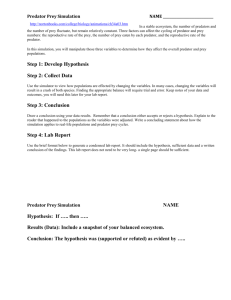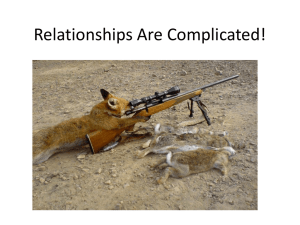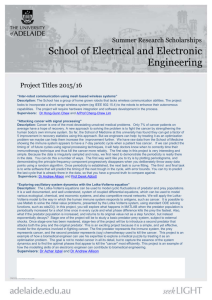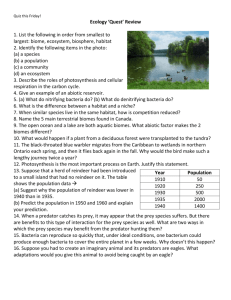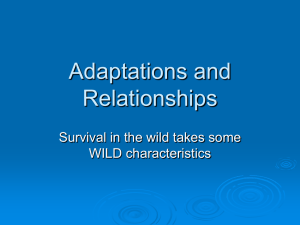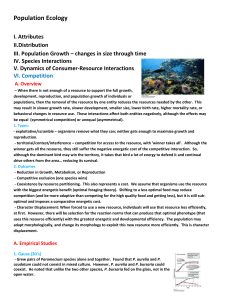Exam 2 sample questions
advertisement
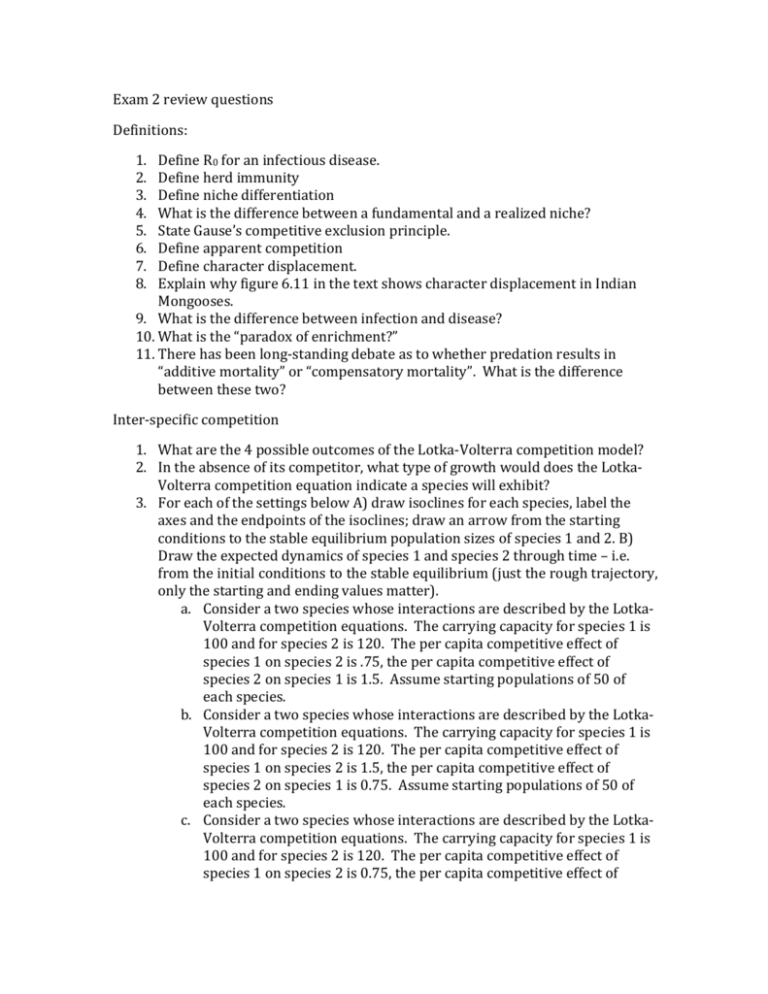
Exam 2 review questions Definitions: 1. 2. 3. 4. 5. 6. 7. 8. Define R0 for an infectious disease. Define herd immunity Define niche differentiation What is the difference between a fundamental and a realized niche? State Gause’s competitive exclusion principle. Define apparent competition Define character displacement. Explain why figure 6.11 in the text shows character displacement in Indian Mongooses. 9. What is the difference between infection and disease? 10. What is the “paradox of enrichment?” 11. There has been long-standing debate as to whether predation results in “additive mortality” or “compensatory mortality”. What is the difference between these two? Inter-specific competition 1. What are the 4 possible outcomes of the Lotka-Volterra competition model? 2. In the absence of its competitor, what type of growth would does the LotkaVolterra competition equation indicate a species will exhibit? 3. For each of the settings below A) draw isoclines for each species, label the axes and the endpoints of the isoclines; draw an arrow from the starting conditions to the stable equilibrium population sizes of species 1 and 2. B) Draw the expected dynamics of species 1 and species 2 through time – i.e. from the initial conditions to the stable equilibrium (just the rough trajectory, only the starting and ending values matter). a. Consider a two species whose interactions are described by the LotkaVolterra competition equations. The carrying capacity for species 1 is 100 and for species 2 is 120. The per capita competitive effect of species 1 on species 2 is .75, the per capita competitive effect of species 2 on species 1 is 1.5. Assume starting populations of 50 of each species. b. Consider a two species whose interactions are described by the LotkaVolterra competition equations. The carrying capacity for species 1 is 100 and for species 2 is 120. The per capita competitive effect of species 1 on species 2 is 1.5, the per capita competitive effect of species 2 on species 1 is 0.75. Assume starting populations of 50 of each species. c. Consider a two species whose interactions are described by the LotkaVolterra competition equations. The carrying capacity for species 1 is 100 and for species 2 is 120. The per capita competitive effect of species 1 on species 2 is 0.75, the per capita competitive effect of 4. 5. 6. 7. species 2 on species 1 is 0.75. Assume starting populations of 50 of each species. d. Consider a two species whose interactions are described by the LotkaVolterra competition equations. The carrying capacity for species 1 is 100 and for species 2 is 120. The per capita competitive effect of species 1 on species 2 is 1.5, the per capita competitive effect of species 2 on species 1 is 1.5. Assume starting population of species 1 is 20 and the starting population of species 2 is 80. What will be the outcome of Lotka-Volterra type inter-specific competition if: a. Species 1 is the superior inter-specific competitor? b. Species 2 is the superior inter-specific competitor? c. Intra-specific competition is stronger for both species than interspecific competition? d. Inter-specific competition is stronger for both species than intraspecific competition? Paine (1979) showed that sea palms and mussels could coexist despite the clear competitive advantage of mussels. a. What was the resource they were competing for? b. Assume that the competitive interaction is characterized by the LotkaVolterra equations. Draw and label the isoclines (you don't need the actual numbers, just label with the symbols). c. Describe the mechanism that allowed the persistence of these two species. Harper (1961) showed that Bromus madritensis and Bromus rigidus could coexist despite the clear competitive advantage of B rididus. a. Assume that the competitive interaction is characterized by the LotkaVolterra equations. Draw and label the isoclines (you don't need the actual numbers, just label with the symbols). b. Describe the mechanism that allowed the persistence of these two species. Give two examples of how environmental heterogeneity may permit an apparently “weak” competitor to coexist with a species that might be expected to exclude it. Predation 1. Draw and label the three types of predator functional responses described by Holling in terms of the prey density (x-axis) and the predator consumption rate (y-axis). 2. Draw and label the three types of predator functional responses described by Holling in terms of the prey density (x-axis) and the percent impact of predation on the prey population (y-axis). 3. My dog has, in the 9 years I've known her, exhibited a Type I functional response with respect to her "prey" (i.e. kibble). What could I do at feeding time to generate a Type II functional response. 4. Based on the optimal diet breadth model, what would you predict to be the difference in a predator with a long handling time compared to a predator with a short handling time? 5. Based on the optimal diet breadth model, what would you predict to be the difference in a predator resource rich environment compared to a predator in a resource poor environment? 6. Based on the optimal patch foraging model (Friday before Spring break!), as patches of resources become more sparse (i.e. further away from each other) what is the prediction for the amount of time that consumers should stay in each patch before leaving? 7. Give an example of a type of consumer for which the conversion efficiency, f, in the Lotka-Volterra predator prey equation is greater than 1. 8. State the 4 assumptions of the Lotka-Volterra predator prey model 9. What are the two characteristic properties of Lotka-Volterra predator-prey cycles? 10. In the absence of its predator, what type of growth would does the LotkaVolterra predator equations indicate a prey species will exhibit? 11. Relative to the dynamics of the classic Lotka-Volterra model, what is the predicted consequence of intra-specific competition in the prey population on predator prey cycles? 12. Draw (and label) a figure of the population size over time (absolute values are not important, only general patterns) for the predator of a prey species that a. Is NOT limited by intraspecific competition b. Is limited by intraspecific competition 13. Give an example of how predation can lead to an increase in species diversity. 14. What empirical observation from Paine’s experimental removal of the sea star Pisaster from the rocky intertidal zone indicates that mussel distribution was limited by predation and not conditions. 15. Hairston, Smith, and Slobodkin propose 3 observations that form the basis of their argument that terrestrial herbivores are primarily limited by predators. What are they? 16. Murdoch disputed HSS’s assertions about why the world was green. What alternative explanation did he offer for why there was so much plant biomass? Parasitism 1. What are the three major classes of microparasites? 2. What are the three quantities that contribute to the basic reproductive ratio, R0, of an infectious disease? For each, describe whether they are positively or negatively correlated with R0. 3. Describe why selection may favor the evolution of intermediate virulence in parasites. 4. Myxomatosis famously declined in virulence following introduction into rabbits in Australia but did not lose virulence completely, suggesting a cost to both extreme virulence and the complete lack of a virulent effect. a. What was the cost to the virus of being highly virulent? b. What was the cost of being avirulent? Predation/Parasitism and Communities 1. Predators can alter the competitive balance between their prey species. Given that 2 prey species differ in their competition for resources, selective predation on which one would most likely lead to more stable coexistence of the prey species? 2. Draw the hypothetical Lotka-Volterra isoclines for the coal tit and the willow tit in the absence of the pygmy owl. 3. Draw the hypothetical Lotka-Volterra isoclines for the coal tit and the willow tit in the presence of the pygmy owl. 4. In the caterpillar and parasitoid wasp example, both caterpillars were able to persist independently in the presence of the parasitoid. When the parasitoids were allowed to feed on both caterpillars, one was excluded. What was the determining characteristic of the one that was NOT excluded. It is also worth remembering that we’ve talked about several specific case-study examples: 1. 2. 3. 4. 5. Deer population crash in the Kaibab Plateau Rabbits and Myxomatosis Voles, lemmings, stoats, etc along a latitudinal gradient in Scandinavia Algae and Rotifers Elephants and rinderpest in the Serengeti

